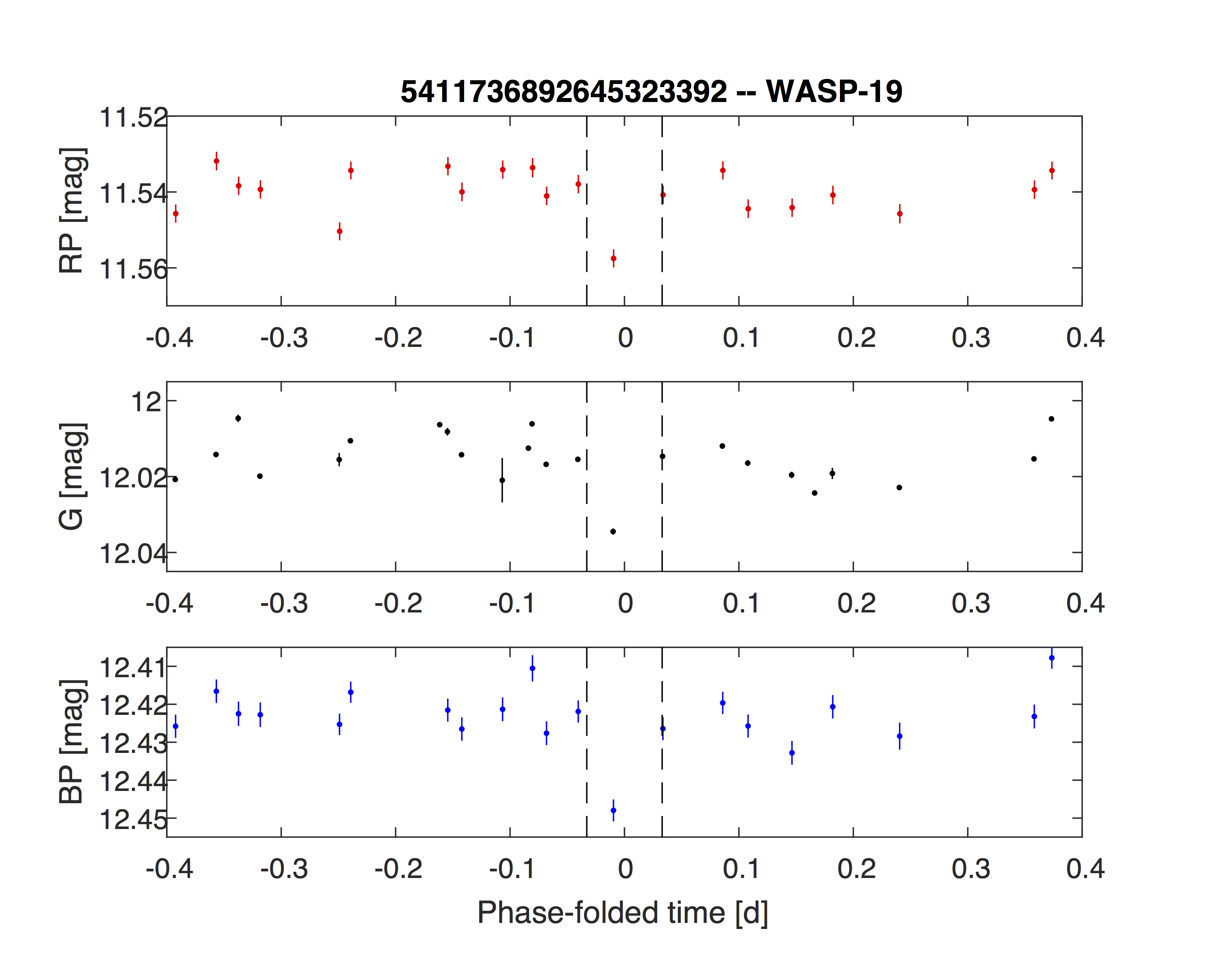IoW_20170209 - Gaia
Image of the Week |
|||
Known EXoplanetary transits In GAia Data |
|||
 |
|||
|
Figure 1: Gaia folded light-curve of WASP-19b in the bands RP, G and BP. The light-curves are shifted to zero transit phase, and folded by the known period. The vertical dashed lines mark the times of transit ingress and egress. (Image credit: ESA/Gaia/DPAC/CU7) |
|||
|
During its nominal five-year mission Gaia is expected to sample a billion Milky-Way stars, on average 70 times each. The Gaia scanning law was optimised for Gaia's main science goal that is precise astrometry and is therefore not optimal for detecting transiting planets. However a test carried out on some known exoplanets suggests that these type of events can be seen in the Gaia data as well, provided enough data is gathered in that area of the sky. Here the results are shown for two examples of known transiting planets observed by Gaia during the mission's first year. Given that only one year of data was available for use in this test, these results provide an encouraging and tantalising hint of what will eventually be possible with the full set of data from the five-year nominal mission. The first example is WASP-19b, which is a planet detected in 2009 by Hebb et al. (ApJ, 708, 224). Its orbital period is 0.7888400+/-3 • 10-7 days, the transit duration is 0.066 days and the transit depth is 0.022 magnitude. During its first year, Gaia sampled WASP-19b only 24 times. Fortuitously, one of those samples occurred during a transit. In Figure 1 the Gaia light-curve can be seen in the G, BP and RP bands, phase-folded according to the known period (using the mid-transit time as the reference epoch). The vertical dashed lines represent the transit ingress and egress, the points in time where the transit starts and ends respectively. The one measurement during transit is indeed 0.02 magnitude fainter than the rest, as expected according to the known transit parameters. |
|||
 |
|||
|
Figure 2: Gaia folded light-curve of WASP-98b in the bands RP, G and BP. The light-curves are shifted to zero transit phase, and folded by the known period. The vertical dashed lines mark the times of transit ingress and egress. (Image credit: ESA/Gaia/DPAC/CU7) |
|||
|
The second example is WASP-98b, which was detected by Hellier et al. in 2013 (MNRAS, 440, 1982). It has a period of 2.962640+/-1.3 • 10-6 days, a transit duration of 0.079 days and a depth of 0.028 magnitude. Again, out of 20 samples, one sample occurred during transit and is apparently a little more than 0.02 magnitudes fainter than the rest. The Gaia light-curve can be seen in Figure 2. Transit signals are expected to be achromatic in stars that are not blended with background stars, meaning that the transit should appear similar in all bands. In both cases presented here, we see that the sample that occurs in transit is similarly fainter in all bands - G, BP and RP - and thus exhibiting the expected achromaticity. Obviously, one sample out of a total of about 20 samples does not qualify as a transit detection, however if we recall that this happened in only one year it shows that in five years we can expect many more cases. It may very well be that there are already previously unknown planetary transits within the current dataset, but we cannot use one or two samples in transit to claim a detection. Significant variability in times other than those of the transit ('out-of-transit variability') can be seen in both cases. This is understandable once the scale of the Y-axis is taken into account. Planetary transit signals are quite weak - of the order of 0.01-0.02 magnitude in the best cases. Stellar light can be variable at this level due to various stellar processes. The samples that occur in transit in these two cases are still fainter. When more data becomes available, detection will become evident by the grouping together of a few samples in the folded ligthcurve, even if one or two samples are almost as faint. As data accumulates during the coming years of the Gaia mission, we expect to detect transiting exoplanets using algorithms similar to the BLS (Kovács, Zucker & Mazeh 2002, A&A, 391, 369) and potentially using auxiliary ground based observations (Dzigan & Zucker 2013, MNRAS, 428, 3641). Thus, Gaia might also serve as an all-sky survey for transiting exoplanets. In DPAC we aim to fully exploit Gaia's potential in this respect. While we wait for data to accumulate to detect hitherto unknown planets, we continue to perform checks for validation purposes on the signatures of known transiting planets in the current Gaia dataset and produce figures such as those presented here. A background story on exoplanets was published simultaneously by ESA to give a more general overview of exoplanetary research performed. |
|||
|
Credits: ESA/Gaia/DPAC/CU7/TAU, Shay Zucker (Tel Aviv University), Leanne P. Guy (University of Geneva), Laurent Eyer (University of Geneva) and the whole CU7 team [Published: 09/02/2017] |
|||
- Removed a total of (17) style text-align:center;
- Removed a total of (1) border attribute.
- Removed a total of (1) cellpadding attribute.
- Removed a total of (1) cellspacing attribute.
Image of the Week Archive
- Removed a total of (1) border attribute.
- Removed a total of (1) cellpadding attribute.
- Removed a total of (1) cellspacing attribute.








































 Sign in
Sign in
 Science & Technology
Science & Technology